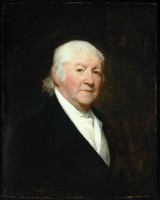
Paul Revere is known for his "Midnight Ride" through the Massachusetts countryside warning fellow patriots that the British were invading. Paul Revere began his journey by rowing across the Charles River to Charleston. He was captured by British soldiers just outside Lexington, questioned, and then relieved of his horse.
Born - January 1, 1735
Died - May 10, 1818
Activities, Lesson Plans, and More
- Y—Young (PreK-3rd)
- M—Middle (4th-6th)
- O—Older (7th-12th)
- T—Teacher Resources
The Paul Revere House
The Paul Revere Memorial Association oversees the care and preservation of three historic buildings – the Paul Revere House, the Pierce/Hichborn House, and its Visitor Center in Lathrop Place. The Association’s website contains educational materials on each of the buildings, biographical information on Paul Revere, a virtual midnight ride, interactive maps, and more.

The Real Story of Revere's Ride
From The Paul Revere’s House in Boston. A quick summary of Paul Revere's ride, some trivia questions, and an interactive map to fully understand the famous ride.
Paul Revere Biography
Henry Wadsworth Longfellow's poem "Paul Revere's Ride," written in 1860 and published in 1861 in the Atlantic Monthly, transformed Paul Revere from a relatively obscure, although locally known, figure into a national folk hero. As a result, most people know him only for his famous ride to Lexington on the night of April 18-19, 1775. Revere's life, however, was a long and productive one, involving industry, politics, and community service.
Paul Revere Biography
This article from the History Channel outlines Paul Revere's life and famous ride.
The Court-Martial of Paul Revere
Years after Paul Revere's famous ride, he was placed under house arrest during the American Revolution. Learn about his arrest and how is name would eventually be cleared in this article from the History Channel.
10 Things You May Not Know About Paul Revere
In addition to his famous ride, Paul Revere was also a silversmith, an artist, and a spy. Learn more fun facts about Paul Revere in this article from the History Channel.
Paul Revere Began His Famous Midnight Ride in 1775
Students learn about primary source documents while studying Paul Revere and researching personal family histories in these lessons from Read Write Think. For grades 4-8.
Paul Revere's Ride
This lesson from the Newberry Library examines the political situation in Boston in 1775, using Henry Wadsworth Longfellow's poem, "The Midnight Ride of Paul Revere". For grades K-2.
Paul Revere's Ride
A transcript of the poem, “The Landlord's Tale. Paul Revere's Ride” by Henry Wadsworth Longfellow.
The Midnight Ride of Paul Revere: Literature v. History
In these lesson plans from the Gilder Lehrman Institute of American History, students will analyze primary source documents and compare them to the narrative of Henry Wadsworth Longfellow’s famous poem, “Paul Revere’s Ride,” to determine fact from fiction. For grades 4-6.
Midnight Ride of Paul Revere: Fact, Fiction, and Artistic License
In this lesson plan from EDSITEment, students will use Grant Wood's painting, “Midnight Ride of Paul Revere,” Henry Wadsworth Longfellow's poem, “Paul Revere's Ride,” and primary source documents to learn how Paul Revere and his Midnight Ride became an American story of patriotism. For grades 9-12.
Why Do We Remember Revere? Paul Revere's Ride in History and Literature
This EDSITEment lesson contains four activities for students to examine how the historical Paul Revere's ride differs from the account in Longfellow's poem. For grades 6-8.
Concord Museum
The Concord Museum in Concord, Massachusetts is home to a large collection of artifacts, digital exhibitions, and educational resources related to the history of the town, the American Revolution, and colonial America. Some of the digital resources you can explore include a virtual tour of Paul Revere's ride, a virtual exhibition on April 19, 1775, photographs of Paul Revere's lantern, and more.
April 19, 1775: Lexington, Concord, and Beyond
A resource guide form the Boston Public Library that includes primary resources related to the events leading up to, during, and after the battles of Lexington and Concord. Inside, you can find maps, letters, military correspondence, and other resources.
Mapping Boston and the American Revolution
A map-based activity from the Norman B. Leventhal Map & Education Center at the Boston Public Library that has students evaluate historic maps of Boston and identify how the city’s geography contributed to the American Revolution. For grades 4-8.
Boston 1775
Boston 1775 is a history blog created by J. L. Bell, a Massachusetts-based writer and historian. The website contains a wealth of information on the start of the American Revolution in Massachusetts, articles on hundreds of niche topics, primary source guides and analysis, and links to additional resources.
One If By Land, and Two If By Sea!
One If By Land, and Two If By Sea! What do students know about Lexington and Concord, the Old North Church, or the historical poem Paul Revere's Ride?
Paul Revere's Deposition, circa 1775
An image and full-text transcription of Paul Revere's deposition prepared for the Massachusetts Provincial Congress that details his ride to Lexington. From the Massachusetts Historical Society.
Letter from Paul Revere to Jeremy Belknap, circa 1798
An image and full-text transcription of a letter written by Paul Revere to Jeremy Belknap, detailing his ride to Lexington. From the Massachusetts Historical Society.




